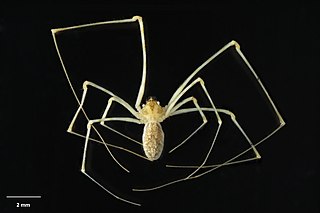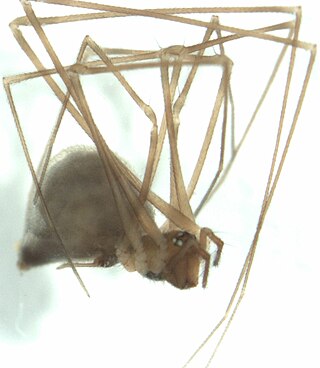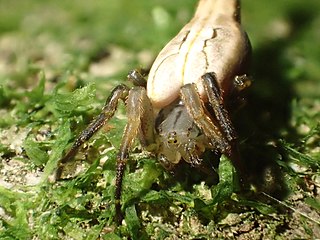
The Agelenidae are a large family of spiders in the suborder Araneomorphae. Well-known examples include the common "grass spiders" of the genus Agelenopsis. Nearly all Agelenidae are harmless to humans, but the bite of the hobo spider may be medically significant, and some evidence suggests it might cause necrotic lesions, but the matter remains subject to debate. The most widely accepted common name for members of the family is funnel weaver.

The katipō is an endangered species of spider native to New Zealand. It is one of many species in the genus Latrodectus, such as the Australian redback, and the North American black widow. The species is venomous to humans, capable of delivering a potentially dangerous bite. It is a small to medium-sized spider, with the female having a round black or brown pea-sized body. Red katipō females found in the South Island and the lower half of the North Island, are always black, and their abdomen has a distinctive red stripe bordered in white. In black katipō females found in the upper half of the North Island, this stripe is absent, pale, yellow, or replaced with cream-coloured blotches. These two forms were previously thought to be separate species. The male is much smaller than the female and quite different in appearance: white with black stripes and red diamond-shaped markings. Katipō are mainly found living in sand dunes close to the seashore. They are found throughout most of coastal New Zealand except the far south and west. Katipō feed mainly on ground dwelling insects, caught in an irregular tangled web spun amongst dune plants or other debris.

The Tanna ground dove, also known as Forster's dove of Tanna, is an extinct dove species. Its taxonomic affiliation is uncertain but at its first scientific discussion by Johann Georg Wagler in 1829 it was classified into the genus Gallicolumba ; its closest relative is possibly the Santa Cruz ground dove. It was endemic to the Pacific island of Tanna, Vanuatu. Forster records a native name mahk, almost certainly from the Kwamera language.

The Tahiti rail, Tahitian red-billed rail, or Pacific red-billed rail is an extinct species of rail that lived on Tahiti. It was first recorded during James Cook's second voyage around the world (1772–1775), on which it was illustrated by Georg Forster and described by Johann Reinhold Forster. No specimens have been preserved. As well as the documentation by the Forsters, there have been claims that the bird also existed on the nearby island of Mehetia. The Tahiti rail appears to have been closely related to, and perhaps derived from, the buff-banded rail, and has also been historically confused with the Tongan subspecies of that bird.

Spelungula is a monotypic genus of South Pacific large-clawed spiders containing the single species, Spelungula cavernicola, or the Nelson cave spider. It was first described by Ray Forster, Norman I. Platnick, & Michael R. Gray in 1987, and has only been found in caves in the northwestern part of New Zealand's South Island.

The North Island robin is a species of Australasian robin endemic to the North Island of New Zealand. It and the South Island robin of the South Island and Stewart Island were once considered conspecific, but mitochondrial DNA sequences have shown that the two lineages split prior to the Pleistocene, and support the classification as two different species.

Dolomedes aquaticus is a fishing spider that lives and hunts along the gravel banks of unforested New Zealand rivers. It prefers open riverbanks where it lives under rocks, usually less than 5 metres from the river. Its colouring allows it to blend in with river stones. Normally nocturnal, it sits and waits for its prey after dark, and can survive for short periods under the water.

Trite planiceps, commonly known as the black-headed jumping spider, is a common jumping spider (Salticidae) endemic to New Zealand and one of about 150 species of jumping spiders in New Zealand.

Zygoballus sexpunctatus is a species of jumping spider which occurs in the southeastern United States where it can be found in a variety of grassy habitats. Adult spiders measure between 3 and 4.5 mm in length. The cephalothorax and abdomen are bronze to black in color, with reddish brown or yellowish legs. The male has distinctive enlarged chelicerae and front femora. Like many jumping spiders, Z. sexpunctatus males exhibit ritualized courtship and agonistic behavior.

Cambridgea is a spider genus in the family Desidae and some of the first endemic spiders described from New Zealand. They are known for constructing large horizontal sheet webs measuring up to a square metre in larger species. Cambridgea were originally assigned to the Agelenidae by Dalmas in 1917 but were reassigned to the Stiphidiidae in 1973. Most recently, both Cambridgea and sister genus Nanocambridgea were reassigned to the Desidae, subfamily Porteriinae on the basis of molecular evidence.

Drapetisca alteranda is a spider in the family Linyphiidae. It is found in the United States. This species can be found in leaves on the ground; however, it is most often found on the surface of various deciduous and coniferous trees.

Pianoa is a monotypic genus of large-clawed spiders endemic to New Zealand. It contains a single species, Pianoa isolata, known commonly as the piano flat spider.

Nomaua is a genus of Polynesian araneomorph spiders in the family Physoglenidae that was first described by Raymond Robert Forster in 1990. Originally placed with the Linyphiidae, it was moved to the Synotaxidae in 1990, and is now considered a senior synonym of Wairua.

Pahoroides is a genus of Polynesian araneomorph spiders in the family Physoglenidae that was first described by Raymond Robert Forster in 1990.

Zeatupua is a monotypic genus of araneomorph spiders in the family Physoglenidae containing the single species, Zeatupua forsteri. It was first described by Fitzgerald & Sirvid in 2009, and is found in New Zealand. Originally placed with the Synotaxidae, it was moved to the Physoglenidae in 2017.

Diploplecta is a genus of South Pacific dwarf spiders that was first described by Alfred Frank Millidge in 1988.
Periegops suterii is a species of spider in the genus Periegops that is endemic to the South Island of New Zealand.

Anoteropsis hilaris, commonly referred as the garden wolf spider or the grey wolf spider, is a species of wolf spider that is endemic to New Zealand.

Arachnura feredayi, the tailed forest spider, is endemic to New Zealand. it is known for the distinctive tapering body shape in females which are also much larger than males, and for producing vertical columns of eggsacs in the 12 o'clock position in their webs.



















